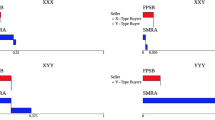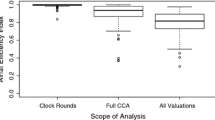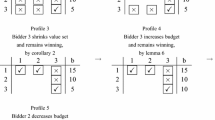Abstract
Combinatorial auctions have been studied analytically for several years, but only limited experimental results are available for auctions with more than 10 items. We investigate the Hierarchical Package Bidding auction (HPB), the Combinatorial Clock auction (CC), and one pseudo-dual price auction (PDP) experimentally, as all these formats were used or suggested for high-stakes spectrum auctions. We want to understand the impact that different auction formats have on bidder behavior and allocative efficiency. Interestingly, we find that the main source of inefficiency in all formats is the bidders’ preselection of packages, rather than their strategies or auction rules; bidders mostly preselect a small number of packages of interest early in the auction. CC achieves high efficiency and revenue in all experiments, but HPB yields similar results even in value models, where hierarchical pre-packaging is difficult. Due to their influence on the decision of the US Federal Communications Commission, we intentionally repeated a set of experiments conducted by Goeree and Holt (GH) [Games and Economic Behavior 70:146–169, 2010], and find similar aggregate results. In addition, we analyze the CC auction and find that this mechanism has advantages in environments where the auctioneers’ hierarchy does not fit the bidders’ preferences well. In addition to the value models with global synergies in GH, we used value models where bidders have local synergies, which play a significant role in spectrum auctions in the field and lead to different results.



Similar content being viewed by others
Notes
We measure efficiency as \(E(X):= \frac{\text{actual surplus}}{\text{optimalsurplus}} \times100\) %.
We measure auction revenue share as \(R(X):= \frac{\text{auctioneer's revenue}}{\text {optimal surplus}} \times100\) %.
All experiments were conducted using the MarketDesigner software, which was developed at the TU München.
∼ indicates an insignificant order, ≻∗ indicates significance at the 10 % level, ≻∗∗ indicates significance at the 5 % level, and ≻∗∗∗ indicates significance at the 1 % level.
References
Ausubel, L., & Milgrom, P. (2006). The lovely but lonely Vickrey auction. In P. Cramton, Y. Shoham, & R. Steinberg (Eds.), Combinatorial auctions. Cambridge: MIT Press.
Ausubel, L., Cramton, P., & Milgrom, P. (2006). The clock-proxy auction: A practical combinatorial auction design. In P. Cramton, Y. Shoham, & R. Steinberg (Eds.), Combinatorial auctions. Cambridge: MIT Press.
Ausubel, L. M., Cramton, P., McAfee, R. P., & McMillan, J. (1997). Synergies in wireless telephony: Evidence from the broadband PCS auctions. Journal of Economics & Management Strategy, 6(3), 497–527.
Banks, J., Ledyard, J., & Porter, D. (1989). Allocating uncertain and unresponsive resources: An experimental approach. Rand Journal of Economics, 20, 1–25.
Banks, J., Olson, M., Porter, D., Rassenti, S., & Smith, V. (2003). Theory, experiment and the FCC spectrum auctions. Journal of Economic Behavior & Organization, 51, 303–350.
Bichler, M., Shabalin, P., & Pikovsky, A. (2009). A computational analysis of linear-price iterative combinatorial auctions. Information Systems Research, 20(1), 33–59.
Brunner, C., Goeree, J. K., Holt, C., & Ledyard, J. (2010). An experimental test of flexible combinatorial spectrum auction formats. American Economic Journal: Microeconomics, 2(1), 39–57.
Chen, Y., & Takeuchi, K. (2010). Multi-object auctions with package bidding: An experimental comparison of Vickrey and iBEA. Games and Economic Behavior, 68, 557–579.
Cowan, N. (2001). The magical number 4 in short-term memory: A reconsideration of mental storage capacity. Behavioral and Brain Sciences, 24, 87–185.
Cramton, P. (2009a). Auctioning the digital dividend, Karlsruhe Institute of Technology.
Cramton, P. (2009b). Spectrum auction design. Papers of Peter Cramton 09sad, Department of Economics, University of Maryland. http://ideas.repec.org/p/pcc/pccumd/09sad.html.
Cramton, P., Shoham, Y., & Steinberg, R. (Eds.) (2006). Combinatorial auctions. Cambridge: MIT Press.
Goeree, J. K., & Holt, C. A. (2010). Hierarchical package bidding: A paper & pencil combinatorial auction. Games and Economic Behavior, 70(1), 146–169.
Güth, W., Levati, M., & Ploner, M. (2010). Satisficing in strategic environments: A theoretical approach and experimental evidence. The Journal of Socio-Economics, 39(5), 554–561.
Hastie, T., & Pregibon, D. (1992). Generalized linear models. In J. Chambers & T. Hastie (Eds.), Statistical models in S. Pacific Grove: Wasworth and Brooks/Cole.
Hoffman, K. (2011). Spectrum auctions. In J. Kennington, E. Olinick, & D. Rajan (Eds.), International series in operations research and management science: Vol. 158. Wireless network design (pp. 147–176). New York: Springer.
Isaac, R., & James, D. (2000). Robustness of the incentive compatible combinatorial auction. Experimental Economics, 3, 31–53.
Kagel, J. H., Lien, Y., & Milgrom, P. (2010). Ascending prices and package bidding: A theoretical and experimental analysis. American Economic Journal: Microeconomics, 2(3), 160–185.
Kirchkamp, O., & Reiss, J. P. (2008). Heterogeneous bids in auctions with rational markdown bidders—theory and experiment. Jena Economic Research Papers 66.
Kwasnica, T., JO, Ledyard, Porter, D., & DeMartini, C. (2005). A new and improved design for multi-objective iterative auctions. Management Science, 51(3), 419–434.
Ledyard, J., Porter, D., & Rangel, A. (1997). Experiments testing multiobject allocation mechanisms. Journal of Economics & Management Strategy, 6, 639–675.
Miller, G. A. (1956). The magical number seven, plus or minus two: Some limits on our capacity for processing information. Psychological Review, 63, 81–97.
Moreton, P. S., & Spiller, P. T. (1998). What’s in the air: Interlicense synergies in the Federal Communications Commission’s broadband personal communication service spectrum auctions. Journal of Law & Economics, 41(2), 677–716.
Porter, D., & Smith, V. (2006). FCC license auction design: A 12-year experiment. Journal of Law Economics and Policy, 3(1), 63–80.
Porter, D., Rassenti, S., Roopnarine, A., & Smith, V. (2003). Combinatorial auction design. Proceedings of the National Academy of Sciences of the United States of America, 100, 11153–11157.
Rassenti, S., Smith, V. L., & Bulfin, R. L. (1982). A combinatorial auction mechanism for airport time slot allocations. Bell Journal of Economics, 13, 402–417.
Rothkopf, M. H., Pekec, A., & Harstad, R. M. (1998). Computationally manageable combinatorial auctions. Management Science, 44, 1131–1147.
Scheffel, T., Pikovsky, A., Bichler, M., & Guler, K. (2011). An experimental comparison of linear and non-linear price combinatorial auctions. Information Systems Research, 22, 346–368.
Schneider, S., Shabalin, P., & Bichler, M. (2010). On the robustness of non-linear personalized price combinatorial auctions. European Journal of Operational Research, 206, 248–259.
Simon, H. A. (1959). Theories of decision-making in economics and behavioral science. American Economic Review, 49, 253–283.
Acknowledgements
The authors thank Jacob Goeree and Riko Jacob for their helpful comments and suggestions. The financial support from the Deutsche Forschungsgemeinschaft (DFG) (BI 1057/3-1) is gratefully acknowledged.
Author information
Authors and Affiliations
Corresponding author
Appendix: Auction Results
Appendix: Auction Results
Rights and permissions
About this article
Cite this article
Scheffel, T., Ziegler, G. & Bichler, M. On the impact of package selection in combinatorial auctions: an experimental study in the context of spectrum auction design. Exp Econ 15, 667–692 (2012). https://doi.org/10.1007/s10683-012-9321-0
Received:
Accepted:
Published:
Issue Date:
DOI: https://doi.org/10.1007/s10683-012-9321-0




